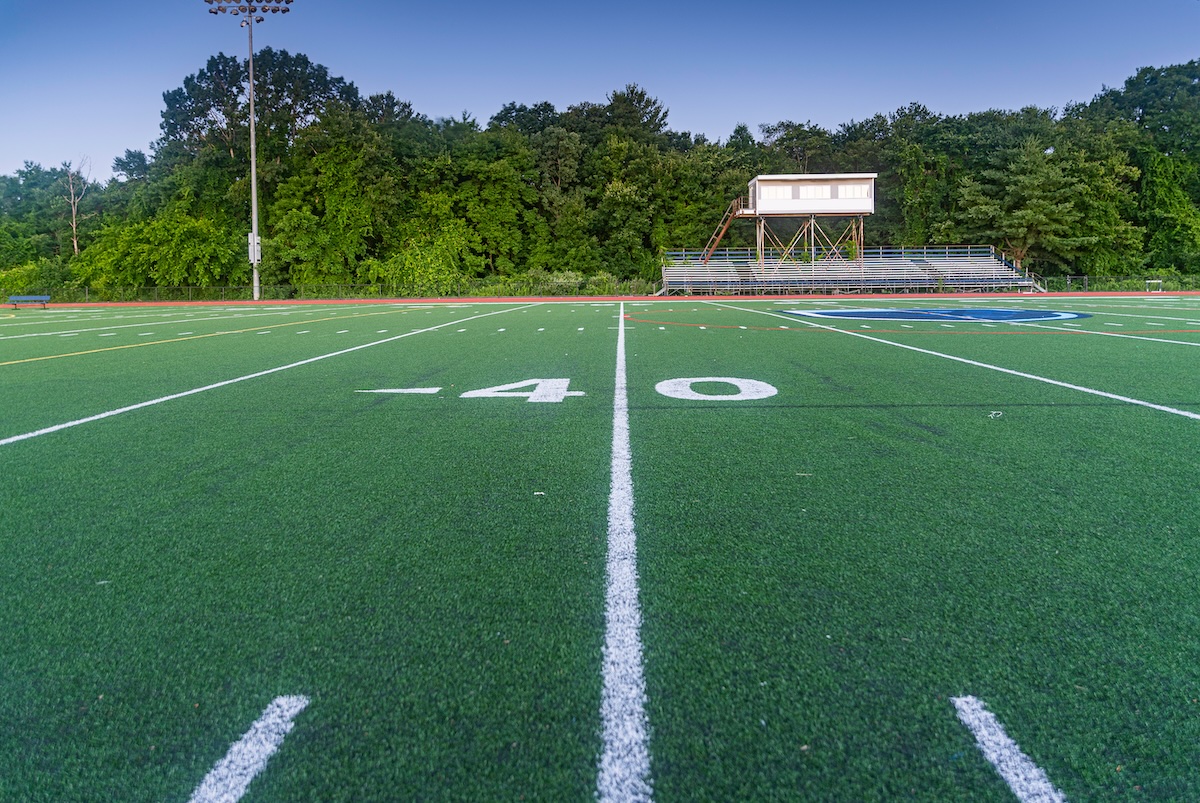Last Updated on July 30, 2025 by UDC Sports
Introduction: What Defines a Sports Surface?
If you’ve ever watched a game-winning goal bounce just right, or seen a player lose their footing at the worst possible moment, you know: the surface matters. It’s not just something under your cleats or sneakers—it’s a critical part of the game itself.
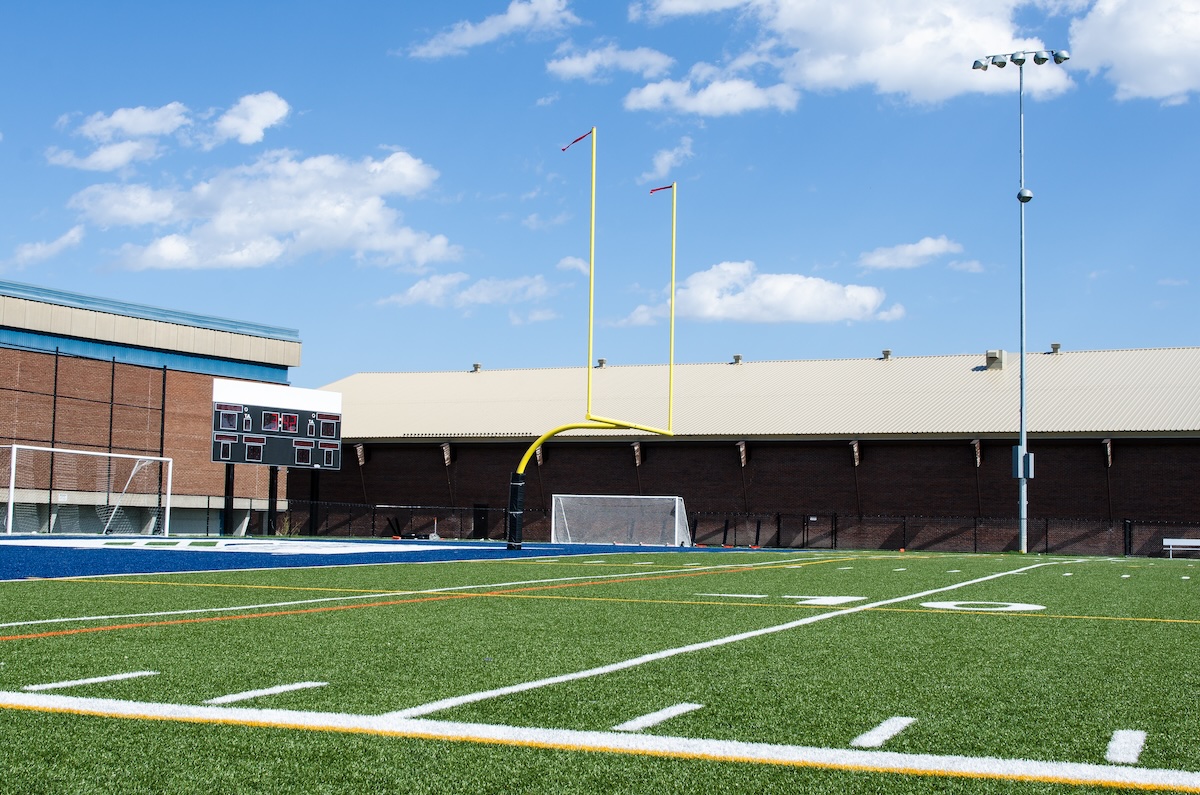
As sports fans, we don’t always think about it, but athletes feel the difference in every cut, sprint, and landing. And for coaches, facility managers, and planners, getting that surface right isn’t just about looks or maintenance—it’s about safety, performance, and long-term durability.
Modern sports surfacing involves more than just “ground cover” for athletic fields and courts. These are engineered systems, designed to optimize athlete performance, reduce injury risk, and withstand the unique demands of specific sports. And whether you’re building a little league baseball diamond, a middle school gymnasium, a high school football field, or a community multi-use facility, the surface beneath the game plays a crucial role in everything from traction to shock absorption.

Outdoor facilities have to contend with environmental exposure, drainage, and UV degradation, while indoor surfaces must balance rebound resilience, friction, and ball control under tightly controlled conditions.
This article explores the full range of sports surface options available today—natural and artificial turf systems, court surfaces, and hybrid/custom builds—while detailing the installation processes, material systems, base prep, and performance tolerances each requires.
Part 1: Surface Categories and Functional Requirements

Before selecting or installing a surface, every project must begin with understanding the sport-specific performance parameters, usage profile, and environmental context. Surface systems are typically divided into four primary categories:
1.1 Natural Turf Systems
Used predominantly for field sports such as soccer, football, and baseball, natural turf requires precise soil grading, turfgrass selection, and long-term agronomic planning. Key variables include:
- Root zone composition: Sand-based systems offer improved drainage and stability over native soil, but demand more intensive fertilization and irrigation.
- Turf species: Selection varies by climate and usage—bermudagrass hybrids dominate warm-season fields, while ryegrass or bluegrass blends are typical in cooler zones.
- Reinforcement options: Natural systems can be augmented with slit-film synthetic stitching (reinforced natural turf) to resist shearing and extend playability during wet conditions.
1.2 Synthetic Turf Systems

Widely used across football, soccer, lacrosse, field hockey, and multi-sport venues, synthetic turf fields offer durability and year-round availability. Key components of artificial grass include:
- Carpet (face yarn): Typically polyethylene monofilament or slit-film fibers tufted into a polyurethane or latex backing.
- Infill system: A layered mix of crumb rubber, sand, thermoplastics, or organic materials provides ballast, traction, and shock absorption.
- Shock pad (optional): Beneath the carpet, a prefabricated or poured-in-place pad moderates G-max values and contributes to energy restitution.
Standards such as ASTM F355 (impact attenuation) and EN 15330 (performance testing) often guide material choices, especially for competitive installations.
1.3 Hard Court and Sport Tile Surfaces
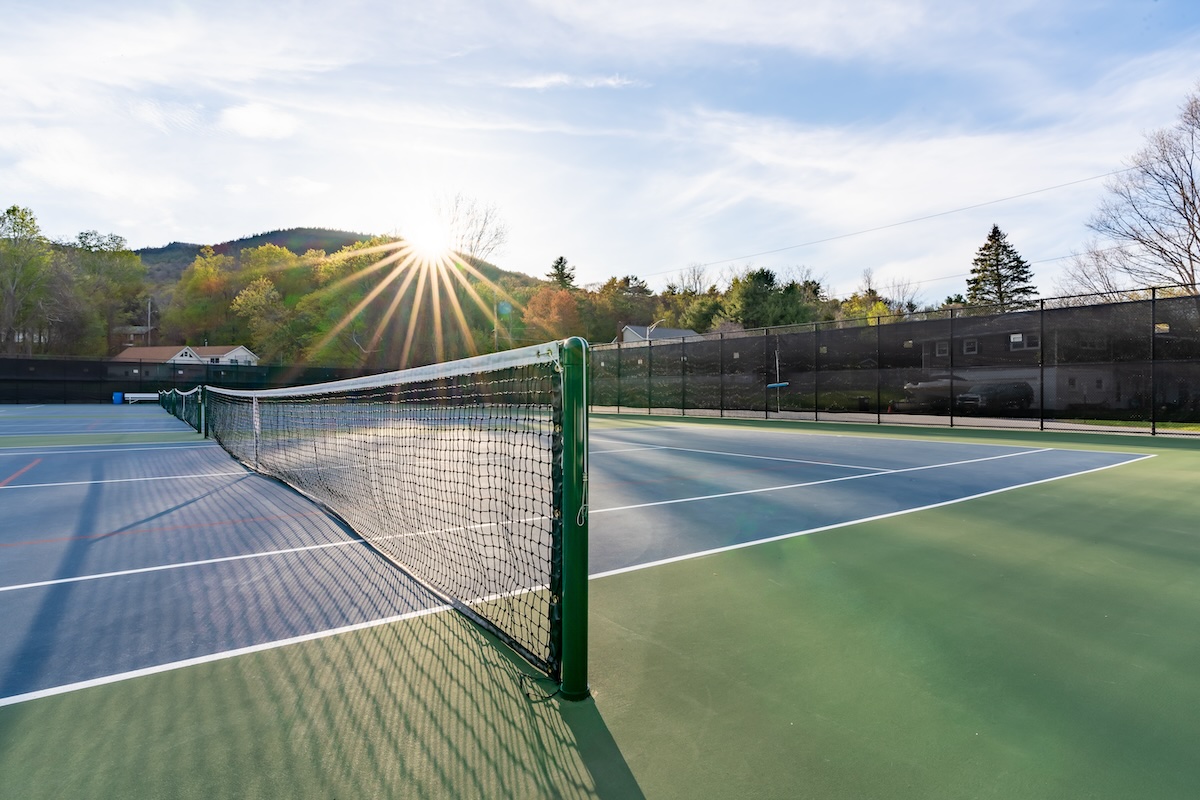
For indoor gyms, tennis courts, and multipurpose courts, surface types include:
- Polyurethane-poured systems: Seamless, cushioned layers bonded to the subfloor. Known for resilience, ball response, and abrasion resistance.
- Vinyl or PVC sheet systems: Multi-layered flooring with fiberglass reinforcement, often used for basketball or volleyball where consistent bounce and line clarity are critical.
- Modular tile systems: Interlocking polypropylene tiles with built-in shock absorption, ideal for quick-install, low-maintenance indoor or outdoor play.
These systems are usually evaluated based on ball rebound, vertical deformation, slip resistance, and abrasion wear (e.g., DIN 18032 standards for indoor sports surfaces).
1.4 Hybrid & Custom Installations
Some facilities require hybrid solutions due to dual-use needs or challenging environments. Examples include:
- Hybrid turf systems: Blends natural grass with reinforcing synthetic fibers to improve field durability in high-traffic zones like goal mouths or between the hash marks—ideal for schools or parks looking to extend the playability of natural turf without switching fully to synthetic.
- Elevated modular courts: Used in locations where existing ground conditions make traditional installation difficult—such as over old asphalt or in areas with poor drainage. These raised, interlocking court systems offer a fast, stable solution for community gyms or rec centers needing a playable surface without full slab reconstruction.
- Perforated cushioned systems: Designed for temporary event use or portable sports installations where drainage, impact control, and fast assembly are priorities.
Part 2: Base Construction and Subgrade Preparation
 No surface system performs well without a precisely constructed base. Subgrade prep varies by site, but shares universal steps:
No surface system performs well without a precisely constructed base. Subgrade prep varies by site, but shares universal steps:
2.1 Soil Testing and Stabilization
- Geotechnical surveys evaluate bearing capacity, soil type, moisture sensitivity, and frost susceptibility.
- Compaction (95% Proctor density or greater) ensures uniform support across the field footprint.
- Stabilization techniques (lime, fly ash, or geotextile separation) may be used to prevent heaving or differential settling in soft soils.
2.2 Grading and Drainage
For outdoor installations, effective drainage is non-negotiable. Systems typically include:
- Laser grading: Achieves sub-base precision within ±¼ inch, critical for drainage performance.
- Crown or slope design: Most natural turf fields have a 0.5–1.5% crown or slope to promote surface runoff.
- Drainage systems: French drains, trench drains, or flat pipe collectors may be embedded under the field. In synthetic systems, permeable stone layers enable vertical drainage through the turf itself.
2.3 Base Materials
The base system must be tailored to the sport surface:
- Natural turf: Often sand-based with peat or organic amendments, capped with a topsoil or rootzone mix.
- Synthetic turf: Multi-layered crushed stone (typically #57 over #89 aggregate), sometimes topped with stone dust or porous asphalt for added stability.
- Indoor courts: Depend on a level concrete slab or engineered wood subfloor with moisture barriers and leveling compounds.
The tolerances here are tight. Deviations in slope, compaction, or thickness can result in pooling, premature wear, or regulatory non-compliance.
Part 3: Surface Installation Procedures and Best Practices
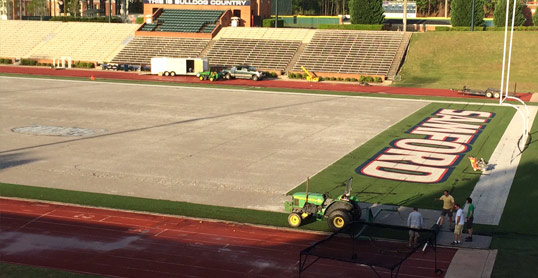
Once the sub-base is fully prepared and validated, surface installation begins. Each material system—natural turf, synthetic turf, and court surfacing—requires specialized procedures to meet performance, durability, and safety specifications.
3.1 Natural Turf Installation
Natural turf fields are either seeded, sodded, or sprigged, depending on climate, sport season, and budget. While seeding is common for long-term projects, elite fields often rely on thick-cut sod or hybrid systems to achieve immediate coverage.
Key Phases:
- Soil amendment and final grading: Root zone mix is tilled to a depth of 4–12 inches depending on soil type and turf selection, then laser graded.
- Turf establishment:
- Seeding: Broadcast, slit-seeding, or hydroseeding using sport-tolerant cultivars.
- Sprigging: Vegetative propagation method used mainly in warm-season grasses like bermudagrass.
- Sodding: Thick-cut sod (1″–1.5″ depth) laid in a staggered, brick-like pattern, tamped for root contact.
- Irrigation setup: Automated systems installed before or concurrent with sod lay. Zones must provide uniform coverage with pressure-adjusted rotors.
- Grow-in and turf maturation: Fertilizer and watering schedules vary by turfgrass species, but grow-in typically spans 4–8 weeks under controlled conditions.
Critical tolerances: ±¼” in grade uniformity, <5% thatch content by weight (for playability), and 50–70% root establishment prior to scheduled use.
That said, not every project needs a stadium-level setup to succeed. Many schools and parks get great results with well-seeded fields and consistent maintenance. The key is matching your approach to your facility’s needs and resources. A smaller field that sees seasonal use might not require reinforced sod or specialty grass blends—just solid soil prep, good drainage, and a realistic plan for upkeep. With a solid foundation in place, even a modest turf field can deliver excellent playability and stand up to daily use.
3.2 Synthetic Turf Installation
Synthetic turf systems require meticulous alignment, seaming, infill distribution, and performance testing.
Carpet Laying
- Acclimatization: Rolls are staged on-site and unrolled to allow relaxation of creases and expansion due to temperature.
- Panel layout: Installed per CAD layout with grain direction matched across rolls. Staggered seams help avoid weak points.
- Seaming: Typically joined with 12-inch wide seaming tape and polyurethane adhesive. Hot melt or mechanical seams may be used in cold-weather installations.
- Edge detailing: Nail boards or anchor trenches secure the perimeter, with attention to transition zones near curbs, pads, or walls.
Infill Application
- Layered process: Infill is added in 3–6 lifts using broadcast spreaders. Each layer is brushed in with oscillating groomers to ensure uniform depth and prevent matting.
- Depth targets: Vary by system type, but often range from 30–50 mm total for rubber/sand blends.
- Settling and top-off: Final grooming includes magnet sweeping, fiber de-compaction, and infill leveling.
Field hardness is validated using G-max testing at multiple zones. Acceptable ranges are typically 90–120 for competition fields; higher readings indicate unsafe impact attenuation.
For schools and community fields, G-max testing doesn’t have to be complicated or expensive—it just helps confirm that the surface is safe to play on. Many facilities include it as part of annual or seasonal maintenance, especially for synthetic turf. If your field gets regular use from contact sports, it’s a smart way to catch any early signs of wear before they turn into safety concerns.
3.3 Court Surface Installation
Whether indoors or out, court surfaces demand precision layering and environmental control. Processes vary by material system:
Poured-in-Place Polyurethane
- Primer application: Bonds coating to concrete or wood subfloor. Moisture vapor emission rates (MVER) must be below threshold before install.
- Base mat layer: A rubber or foam mat is troweled or rolled out to provide shock absorption. Thickness is carefully gauged by sport type (e.g., thicker mats for volleyball, thinner for basketball).
- Resin pours: Self-leveling polyurethane poured over mat, often in multiple layers.
- Topcoat system: Includes pigmented polyurethane with embedded game lines. Slip coefficient, gloss level, and color contrast must meet sport regulations.
Vinyl Roll Systems
- Adhesive application: Pressure-sensitive or full-spread adhesive used depending on traffic load and substrate prep.
- Heat welding seams: After adhesive sets, seams are grooved and welded with matching vinyl rods to create watertight, seamless transitions.
- Perimeter detailing: Cove bases and transitions to other flooring types handled via heat-molded or preformed accessories.
Modular Tile Systems
- Floating installation: Most tiles interlock and sit above the slab without adhesives, using expansion gaps at the perimeter.
- Leveling: Subfloor must be flat within 3mm over 3m. Self-leveling compound may be required if surface deviates.
- Performance tuning: Shock pads may be used beneath tiles to adjust vertical deformation and force reduction.
Indoor installations are subject to slip resistance (ASTM D2047), rebound (DIN 18032), and surface deformation testing.
3.4 Quality Assurance and Post-Install Testing
No install is complete without system-level validation. For school and community projects, this kind of testing doesn’t need to be intimidating. Most of it comes down to making sure the surface is safe, consistent, and built the way it was planned. Even basic checks—like confirming infill depth, making sure seams are tight, or testing how a ball bounces—can go a long way toward spotting issues early.
For Turf Systems:
- G-max testing: Impact attenuation measured using drop hammer apparatus.
- Surface planarity: Checked with laser equipment or straightedges. Tolerance: typically within ±½ inch over 10 feet.
- Infill depth audits: Measured via depth probes at multiple grid points.
For Court Systems:
- Rebound consistency: Ball drop tests check bounce height uniformity.
- Slip resistance: Wet and dry coefficient of friction testing (ASTM D2047 or DIN 51130).
- Seam integrity: Welds or adhesives checked for bond strength, cleanliness, and alignment.
Documented testing and certifications may be required before turnover, especially in professional or public venues governed by sports federations or building codes. And while not every facility needs formal certifications, keeping records of these post-install checks can be a good way to protect your investment and show due diligence if questions ever come up.
Part 4: Maintenance, Repair, and Lifecycle Management
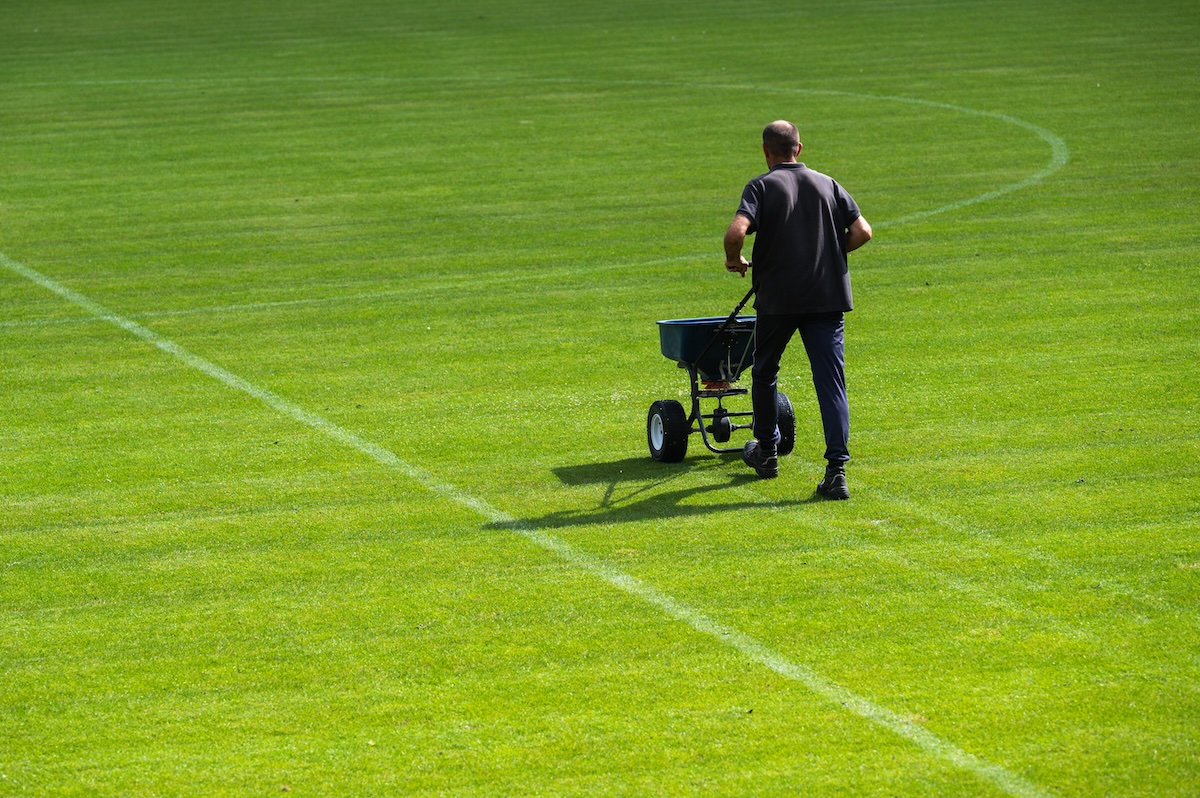
Even the most precisely installed sports surface will degrade without ongoing care. From organic thatch buildup on natural turf to seam failures in synthetic systems, each surface type brings its own vulnerabilities. A proactive maintenance strategy—aligned with the surface material, usage patterns, and climate—is essential for maintaining safety, performance, and regulatory compliance.
That said, you don’t necessarily need a full-time grounds crew to keep things in good shape. Most high-quality surfaces hold up well with routine upkeep and a few key seasonal check-ins. It’s less about doing everything perfectly and more about staying consistent—catching small issues before they turn into big ones.
For many schools and rec facilities, artificial turf ends up being the most straightforward surface to care for. There’s no mowing, watering, or fertilizing to worry about, and it holds up well across all seasons. Maintenance mostly comes down to keeping the infill level, brushing it out now and then, and checking for wear in high-use zones. It’s a simple routine that can usually be handled in-house, making it a great fit for programs with limited grounds staff or tight schedules.
With the right maintenance plan, your field or court can stay safe, playable, and game-ready for years to come.
4.1 Natural Turf Maintenance
Natural grass fields are living systems. Their maintenance isn’t just about mowing—it’s a biological balancing act involving soil health, water management, and seasonal agronomy.
Core Practices:
- Mowing height and frequency: Varies by species and sport. Football fields may be cut at 1.5–2.5″, while baseball outfields are often left taller. Sharp blades and consistent intervals prevent blade bruising and weed encroachment.
- Irrigation: Scheduled based on evapotranspiration rates, not fixed calendars. Smart irrigation controllers with soil moisture sensors are increasingly used to balance hydration with runoff control.
- Fertilization: Nutrient plans target macro (N-P-K) and micro-elements, adjusted seasonally. Leaf tissue analysis guides corrections.
- Aeration and topdressing: Core aeration relieves compaction and allows gas exchange. Sand topdressing helps regulate moisture and smooth play surfaces.
- Pest and weed control: Integrated Pest Management (IPM) programs use targeted herbicides and biological treatments to manage infestations without overapplication.
Repair Cycles:
- Divot repair and overseeding after high-use periods.
- Sod replacement for worn goal mouths, base paths, or sidelines.
- Laser regrading every 5–7 years to restore slope and evenness.
Lifecycle: A high-quality natural turf field may remain viable for 8–12 years with aggressive maintenance, or as little as 3–5 years under heavy use without downtime.
4.2 Synthetic Turf Maintenance

While synthetic turf eliminates mowing, fertilization, and watering, it still requires some regular grooming, sanitation, and performance validation.
Routine Maintenance:
- Brushing/grooming: De-compacts infill, realigns fibers, and removes surface debris. Typically done weekly or biweekly depending on use.
- Infill redistribution: High-traffic zones (goal areas, sidelines) lose infill faster. Redistributing it prevents base layer exposure and impact injuries.
- Debris removal: Organic debris accelerates microbial growth. Specialized vacuums or tow-behind sweepers help avoid contamination.
- Surface disinfection: Especially for contact sports, antimicrobial sprays or UV treatment systems are used to manage bacteria and fungi.
Periodic Maintenance:
- G-max testing: Regular impact testing to track shock attenuation over time. Infill top-offs or shock pad adjustments may be required if values trend too high.
- Seam inspections: Seams can separate due to temperature cycling, turf shrinkage, or heavy lateral stress. Repairs involve reactivating adhesive or stitching, depending on the failure.
- Edge anchoring: Nailers or trench anchors can loosen over time, especially in freeze-thaw zones. These are inspected annually and reinforced as needed.
Lifecycle: Typical synthetic turf fields last 8–10 years under normal use. Degradation signs include fiber splitting, discoloration, infill migration, increased G-max values, and odor buildup. Shock pads may outlast the turf layer and be reused if intact.
4.3 Court Surface Maintenance
Court systems demand high surface uniformity and cleanliness to prevent injury and preserve playability.
Daily & Weekly Practices:
- Dust and debris removal: Dry mops and auto-scrubbers maintain surface clarity and friction balance.
- Spot cleaning: Sweat, tape residue, and scuff marks must be removed using pH-neutral cleaners approved by the floor manufacturer.
- Line integrity checks: Game lines can fade or wear unevenly. Repainting or resurfacing may be needed on an annual basis.
Material-Specific Care:
- Poured polyurethane courts: Sensitive to UV and shoe marks. Protective coatings may be refreshed every 2–4 years.
- Vinyl systems: Welds and seams should be inspected for moisture intrusion, particularly after equipment drops or water exposure.
- Modular tiles: Inspected for warping, broken tabs, or seam gaps. Damaged tiles can be individually replaced without disturbing the whole floor.
Lifecycle: Indoor court systems can last 15–25 years depending on material and use. Outdoor courts (e.g., tennis or basketball) face UV degradation and may require resurfacing every 3–7 years, especially in climates with freeze-thaw cycles. In lower-traffic gyms, surfaces may last significantly longer before full resurfacing is needed—especially with proper cleaning and spot repairs.
4.4 Performance Monitoring & Lifecycle Planning
Facilities that serve multiple teams or host tournaments benefit from formal surface management plans. These are living documents that track:
- Installation specs and as-built drawings
- Maintenance logs (with timestamped procedures)
- G-max and deformation test results over time
- Fertilization and irrigation schedules (for turf)
- Incident logs for slips, injuries, or surface failures
Monitoring not only supports warranty compliance but also informs end-of-life decisions. If surface hardness exceeds safe thresholds or turf fibers exceed wear tolerances, resurfacing may be required before catastrophic failure or liability risk.
While still uncommon in most school or municipal settings, some larger facilities and newly built synthetic turf fields are beginning to adopt smart monitoring tools. These systems can measure usage hours, surface temperature swings, and infill compaction to help guide maintenance—but for most community-level fields, traditional inspections and hands-on upkeep remain the primary approach.
Part 5: Other Applications

Not every sports facility fits neatly into a single use case or surface category. Today’s venues are more dynamic, often combining indoor training areas with outdoor game fields, supporting multiple sports within the same footprint, or even hosting entirely non-sport activities between seasons. For planners, that demands flexibility in surface selection, anchoring systems, and material compatibility.
5.1 Custom and Multi-Use Surface Design
Many school and community facilities need surfaces that can handle more than one purpose—or adapt to the unique layout of an existing space. These design choices don’t always mean building something from scratch, but they often involve site-specific modifications that help the surface perform across seasons, sports, and events.
Custom installations can emerge anywhere where athletic facilities face overlapping requirements, such as:
- Convertible layouts: Fields that serve football in fall, lacrosse in spring, and host community events during off-seasons. These require line striping strategies (permanent, removable paint, or inlaid lines) and wear-zone reinforcements.
- Heavy-use buffer zones: Sidelines, player boxes, and goal creases wear faster. Designers may choose to upgrade these sections with higher-density turf, reinforced seams, or replaceable panels.
- Drop-in floor systems: For arenas that transition between basketball, volleyball, and wrestling, modular hardwood or sport tile surfaces allow for rapid changeover with minimal impact on the base system.
These hybrid strategies must still meet the governing body performance criteria for each sport. Shock absorption, traction, and rebound behavior may need to be balanced between conflicting requirements—what works for one sport may not meet specifications for another.
A field that doubles as a marching band practice space may need extra compaction resistance along its central corridor. A gym that hosts both elementary PE and high school volleyball might need line striping that balances clarity with minimal visual clutter. Even the choice of shock pad thickness or surface texture can be adjusted based on how athletes are using the space and what kind of equipment is being moved across it.
5.2 Indoor-Outdoor Surface Continuity
In some facilities—like schools with a gym that opens up to a turf field or a rec center that connects indoor training areas with outdoor courts—you’ll run into spots where indoor and outdoor surfaces meet. These transitions might happen at doorways, roll-up garage openings, or shared sideline areas. In those zones, it’s important to manage things like surface height changes, moisture control, and traction consistency to make sure athletes can move safely and confidently from one surface to the next.
Environmental Control and Continuity Challenges:
- Thermal expansion and contraction: Indoor and outdoor components experience different thermal loads. Expansion joints and flexible adhesives help accommodate this movement at transition seams.
- Moisture barrier continuity: Indoor courts typically require vapor barriers beneath slabs to prevent moisture intrusion from below, while outdoor fields depend on subsurface drainage systems to manage rainfall and runoff. Proper flashing and trenching must manage the moisture handoff at the doorway or threshold.
- Traction consistency: Transitions between outdoor synthetic turf and indoor vinyl or poured urethane must maintain friction continuity to prevent injury, especially where athletes are sprinting in from one zone to another.
In integrated facilities, even visual and psychological consistency—such as color palette, elevation changes, and lighting uniformity—affects player comfort and perception of space.
5.3 Material Science Trends and Innovation
The materials we use for sports surfaces keep getting better—not just for performance, but also for safety, longevity, and environmental impact. A lot of the newer systems hitting the sports construction world are shaped by two big drivers: how well they hold up under constant use, and how responsibly they’re made. Here are a few of the key trends shaping where the industry’s headed.
Bio-Based & Recycled Material Systems
- Organic infills: Cork, coconut husk, olive pits, and walnut shell blends are being adopted in place of crumb rubber, especially in eco-sensitive or school settings.
- Recyclable shock pads: Modular pads made of thermoplastic elastomers that can be reused across turf lifecycles, reducing material waste during resurfacing.
- Low-VOC coatings and adhesives: In court systems, new formulations minimize volatile organic compounds without compromising bond strength or curing times.
Modular, Scalable Systems
- Panel-based field decks: Portable, high-durability systems allow fields to be reconfigured or relocated entirely—ideal for event venues, rooftops, or urban athletics.
- Smart integration points: Mounting anchors, sleeve systems, and underlayment designs are now being standardized to support retractable goals, netting, and fitness equipment with minimal surface disruption.
The Future of Sports Fields: Performance Monitoring Technologies
A small number of advanced turf systems are beginning to incorporate embedded sensors that track surface temperature, usage frequency, and compaction levels over time. In some elite facilities, this data is even paired with athlete-wearable tech to monitor things like injury risk or optimal training zones based on field conditions. While these tools are still well beyond what most schools or municipalities currently implement, they’re shaping the direction of future standards.
Ongoing research and product development are also focusing on surface durability under environmental stress—including UV exposure, freeze-thaw cycles, and field temperature spikes. For most school and community projects today, this research influences material selection more than active tech deployment, but it’s something that may factor into future facility upgrades or phased planning down the line.
Conclusion: Surface Systems as Athletic Infrastructure
When people think about sports construction, they usually picture the scoreboard, the bleachers, maybe the lighting—but the surface is where everything starts. If the field or court isn’t right, none of the other stuff matters. It affects how athletes move, how safe the game is, and how long that facility will hold up after the season starts taking its toll.

Putting in a sports surface—whether it’s artificial turf, hardwood, grass, vinyl, or anything in between—isn’t just one decision. It’s a whole process that takes some real planning. Everything from the soil under your feet to how you handle shock absorption plays a role in how the surface performs day after day.
So whether you’re building a school sports field, a rec center court, or a community space that sees everything from youth soccer to Friday night football, the key is to build it for real use—not just how it looks when it’s brand new. The surface beneath the action must be engineered for the real-world demands of sport.
Get the base right, pick the surface that fits your needs, and think ahead about how it’s going to be maintained.

Choosing and installing a sports surface isn’t a single decision—it’s an infrastructure commitment. Each element of the system, from subgrade compaction to infill calibration and post-install G-max validation, contributes to the safety, performance, and longevity of the athletic environment.
In the end, the best sports surfaces don’t call attention to themselves. They just work—quietly, reliably—so the game can shine.

